Physical Address
304 North Cardinal St.
Dorchester Center, MA 02124
The parathyroid glands, the last major organ to be recognized in humans, were discovered in 1880 by Ivar Sandstrom, a Swedish medical student, as recounted by Aidan Carney in his delightful essay on the subject.
Normally, there are four oval, pliable parathyroid glands, each averaging 4 × 3 × 1.5 mm. In rare cases, more than four glands are present. In their classic study of 527 autopsy cases, Gilmour and Martin reported two instances in which there were six glands (0.2%) and 31 in which there were five (5.2%). Variations in the weights of the normal glands were studied by the same authors, who found that the mean weight of all four glands was 117.6 ± 4 mg in men and 131.3 ± 5.8 mg in women. The color varies from reddish brown to light tan to yellow, depending on fat content, which in turn depends on age, nutrition, and activity of the individual.
Parathyroid glands are arranged in two pairs. The upper pair arises from the fourth branchial cleft and descends into the neck with the thyroid gland during embryonic life. The lower pair arises from the third branchial cleft and descends into the neck with the thymus. Normally, the upper pair is located on the middle third of the posterolateral border of the thyroid gland, and the lower pair is close to the lower pole of the thyroid gland, near the inferior thyroid artery. The parathyroid glands usually have a symmetric distribution—when one superior parathyroid gland is located in one place, the opposite parathyroid gland will usually be in the contralateral mirror image of that place.
The vascular supply of the lower parathyroid glands comes from branches of the inferior thyroid arteries. This supply is usually independent; a circumstance that may be helpful in locating abnormally placed glands. If one of these arteries is ligated, infarction of the parathyroid gland may result.
Faulty migration of the glands during embryonic life may result in anomalous positions. The upper glands may be found inside the carotid sheath or behind the cervical or thoracic esophagus. The lower glands may continue their descent with the thymus into the anterior portion of the mediastinum. They may also be located inside the thyroid gland (0.2%), in the pharynx, or within the vagus nerve. Interestingly, they can also be found within autonomic ganglia in the neck. Wang has pointed out that despite the wide distribution patterns that parathyroid glands may exhibit, these fall into an orderly scheme and can be uncovered by the experienced surgeon in the great majority of cases, although some patients have required multiple surgeries to identify anomalously located diseased glands.
In the past a rigid division of cell types has been applied to the normal parathyroid gland; however, evidence suggests that this organ is made up of but one basic cell type, the chief cell , and that all the other cells that have been described represent morphologic variations of the former that reflect differences in physiologic activity.
The chief cell measures 6–8 µm in diameter and has a centrally located nucleus and a moderate amount of pale granular cytoplasm. Ultrastructurally, there are variable amounts of glycogen particles and secretory droplets, an inverse relationship existing in the amount of these two components. Parathormone (PTH) and PTH-related protein secretion can be demonstrated immunohistochemically. There is also cytoplasmic reactivity for various types of keratin, and for chromogranin A, but not for vimentin, glial fibrillary acidic protein, neurofilament, or chromogranin B.
The oxyphil cell has a more abundant cytoplasm, which is deeply granular and acidophilic. A rich content of oxidative enzymes can be demonstrated histochemically, although the ratio of enzyme content per mitochondrion seems to be decreased. These oxyphilic cells are often present in the form of nodular collections. Transitional oxyphil cells have an appearance that is intermediate between chief cells and oxyphil cells. The water-clear cell (rarely if ever seen in the normal gland) is characterized by abundant optically clear cytoplasm and sharply defined cell membranes. Transitional water-clear cells have an appearance that is intermediate between chief cells and water-clear cells. Both types of transitional cell are more common in hyperfunctioning than in normal glands.
The frequency distribution of the different cells varies with the age of the patient. Until puberty, the gland is composed wholly of chief cells that contain cytoplasmic glycogen but not fat. The latter appears in these cells as very fine droplets soon after puberty at about the same time that the oxyphil cells appear. They appear first singly, then in pairs, and, after 40 years of age, in the form of sharply outlined but not encapsulated islands, which may be large.
After puberty, mature adipose tissue appears in the stroma and increases in amount until about 40 years of age, remaining relatively constant thereafter. Whereas the average percentage of stromal fat cell in the adult parathyroid is about 40%, the variations in the amount of fat present (while the parenchymal cell content remains relatively constant) make it very difficult to distinguish a normal from an abnormal parathyroid solely on the basis of stromal fat content. In a classic study, Gilmour demonstrated in 1947 that small parathyroid glands in adult individuals are the result of a decreased amount of stromal fat rather than parenchymal cell mass.
A few follicles and cysts of varying sizes are observed in about half of parathyroid glands after puberty. They may be filled with granular and cellular debris or with a dark blue–staining, finely granular material that is morphologically indistinguishable from thyroid colloid. This material, which sometimes is positive with amyloid stains, is thought to result from a conformational change in the stored PTH polypeptide. When these follicles are present, the distinction between thyroid and parathyroid tissue may become difficult, especially on frozen section. The presence of sizable amounts of cytoplasmic glycogen favors a parathyroid nature. Conversely, the presence of birefringent crystals of calcium oxalate (easily detectable with polarized light) favors thyroid, a feature to remember at the time of frozen section. If doubts persist, immunohistochemical stains (e.g. for thyroglobulin, TTF-1, PTH, and/or chromogranin) should dispel them.
The parathyroid glands mediate their endocrine function through the production of PTH, an 84-amino acid polypeptide that results from serial cleavage of preproparathyroid hormone and proparathyroid hormone. There are several forms of circulating PTH. The relationship among them is not clear, but it is known that the structural requirements for the biologic activity reside in the first 34 amino acid residues. The chief cells are most critically sensitive to calcium concentrations in vivo and in vitro.
PTH and vitamin D are the primary regulators of mineral metabolism. The primary target organs for PTH activity are the kidneys, intestines, and bones. The most important physiologic actions of PTH are increased renal excretion of phosphate, increased renal tubular reabsorption of calcium, increased intestinal absorption of calcium, and direct effects in bone. The latter are mainly manifested by an increase in the number of osteoclasts and an apparent increase in their phagocytic activity, resulting in resorption of bone tissue.
Parathyroid adenomas occur in women and men in a ratio of 3 : 1. They can develop at almost any age, but most occur in patients in the fourth decade. A few cases have been reported in children, and some after radiation therapy to the head and neck region. The vast majority are solitary masses. Cases of double or triple adenomas exist, but the distinction between multiple adenomas and asymmetrical hyperplasia can be difficult and arbitrary. Accordingly, some of the reported cases of multiple adenomas would be reinterpreted today as examples of chief cell hyperplasia. Their size and weight vary greatly, with the majority being too small to allow detection on palpation of the neck. Some may be recognizable only microscopically (“microadenomas”). Adenomas are usually oval, may show slight lobulation, and are surrounded by a thin connective tissue capsule. On section, they are often grayish brown ( Fig. 9.1 ). Foci of hemorrhage, calcification, and cystic change may occur. In terms of location, about 75% involve one of the lower glands ( Fig. 9.2 ), 15% involve one of the upper glands, and 10% occur in anomalous positions. Of the latter, 70% are in the mediastinum, 20% are intrathyroidal, and the remainder in the soft tissues behind the esophagus or—in rare cases—the esophageal wall itself.
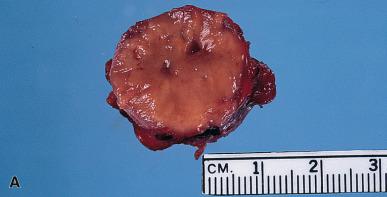
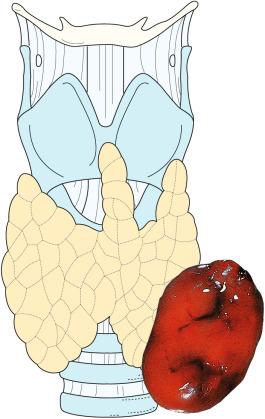
Microscopically, adenomas are encapsulated and highly cellular ( Fig. 9.3 ). An adjacent rim of compressed non-neoplastic parathyroid tissue can be identified in about 60% of cases. The adenoma itself may be composed of any of the various cell types that make up the normal parathyroid gland (see Fig. 9.3 ), but chief cells usually predominate. Combinations of chief cells, oxyphil cells, water-clear cells, and transitional elements are common. Variation in nuclear size may be conspicuous, with the presence of tumor cells with isolated or clustered huge hyperchromatic nuclei ( Fig. 9.4 ). Mitotic figures are usually absent, but occasional ones may be found. The pattern of growth is generally diffuse, but it may be nesting, follicular, or pseudopapillary ( Fig. 9.5 ). The follicles may contain a colloid-like material. This material sometimes stains for amyloid, as in the normal gland. The presence of follicular structures may closely simulate the appearance of thyroid. Presence of birefringent crystals is a good clue for the identification of the latter. Occasionally, prominent clusters of mature lymphocytes of B and T cell type (sometimes admixed with plasma cells) are seen scattered throughout the tumor ( Fig. 9.6 ). This may be accompanied by degenerative changes in the tumor cells. It is important not to overdiagnose this inconsequential microscopic finding, which may or may not have an autoimmune pathogenesis, as a lymphomatous infiltrate.
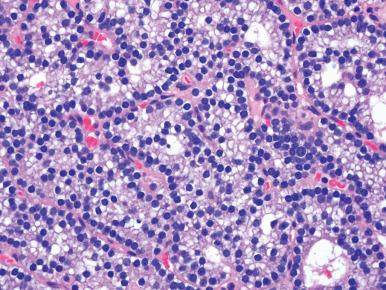
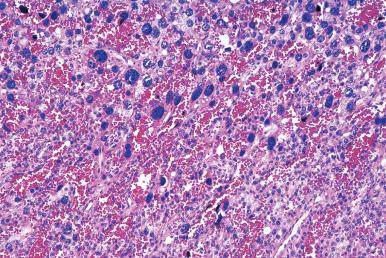
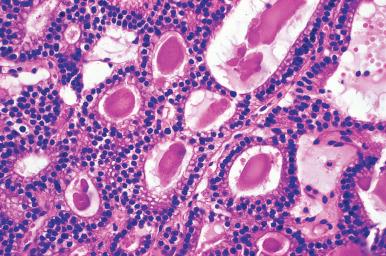
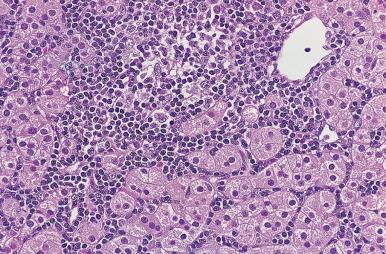
In the typical case of parathyroid adenoma, the other parathyroid glands have a normal or even atrophic appearance. Indeed, the presence of a microscopically normal second gland is thought to represent the best evidence that a given parathyroid lesion is an adenoma rather than chief cell hyperplasia, although the surgical practice of biopsying a second gland to demonstrate its normalcy in order to establish a diagnosis of adenoma has fallen out of favor and has been replaced in part with visualization of the other glands and intraoperative PTH monitoring.
Immunohistochemically, there is reactivity for PTH, various types of keratin, and neuroendocrine markers (e.g. chromogranin A and synaptophysin). The intensity of the PTH staining tends to be weaker in the adenoma than in the peripheral rim of residual normal gland. The adenoma cells express neurofilament, an intermediate filament not found in normal parathyroid cells. Cyclin D1 and bcl-2 expression can be observed in a subset of adenomas, whereas immunoreactivity for p53 is rare. Expression of Ki-67 is observed, but the frequency of positive cells is lower compared to carcinoma. The large majority of adenomas express parafibromin, the gene product of CDC73 , which is lost in the majority of parathyroid carcinomas.
Become a Clinical Tree membership for Full access and enjoy Unlimited articles
If you are a member. Log in here